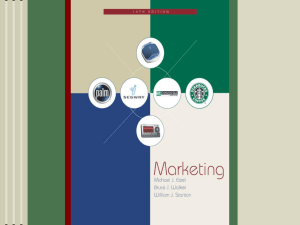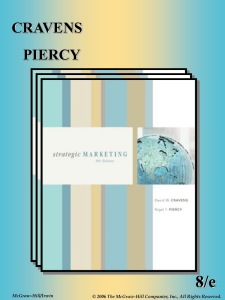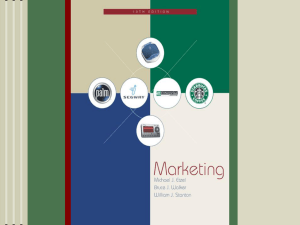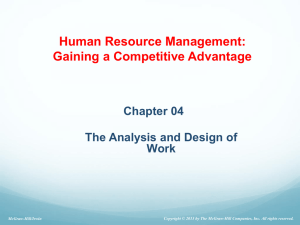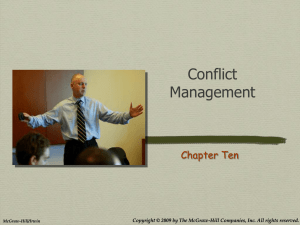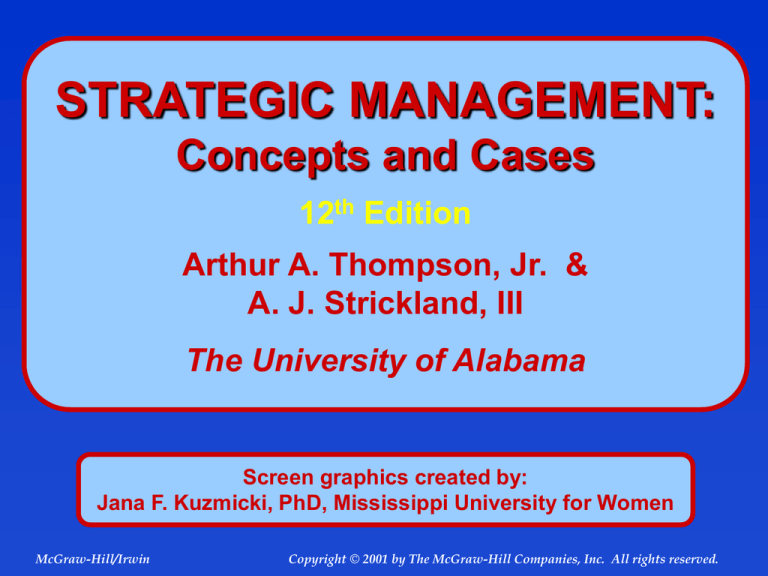
STRATEGIC MANAGEMENT:
Concepts and Cases
12th Edition
Arthur A. Thompson, Jr. &
A. J. Strickland, III
The University of Alabama
Screen graphics created by:
Jana F. Kuzmicki, PhD, Mississippi University for Women
McGraw-Hill/Irwin
Copyright © 2001 by The McGraw-Hill Companies, Inc. All rights reserved.
CHAPTER 1
THE STRATEGIC
MANAGEMENT
PROCESS
Screen graphics created by:
Jana F. Kuzmicki, PhD, Mississippi University for Women
McGraw-Hill/Irwin
Copyright © 2001 by The McGraw-Hill Companies, Inc. All rights reserved.
2
“Without a strategy the organization
is like a ship without a rudder, going
around in circles.”
Joel Ross and Michael Kami
“Quote”
McGraw-Hill/Irwin
Copyright © 2001 by The McGraw-Hill Companies, Inc. All rights reserved.
Chapter Outline
Five Tasks of Strategic Management
Developing a Strategic Vision and Mission
Setting Objectives
Crafting a Strategy
Implementing and Executing the Strategy
Evaluating Performance and Initiating
Corrective Adjustments
Why Strategic Management Is a Process
Who Performs the Tasks of Strategy?
Benefits of “Thinking and Managing
Strategically”
McGraw-Hill/Irwin
Copyright © 2001 by The McGraw-Hill Companies, Inc. All rights reserved.
4
Thinking Strategically:
The Three Big Strategic Questions
1. Where are we now?
2. Where do we want to go?
Business(es) to be in and market
positions to stake out?
Buyer needs and groups to
serve?
Outcomes to achieve?
3. How do we get there?
McGraw-Hill/Irwin
Copyright © 2001 by The McGraw-Hill Companies, Inc. All rights reserved.
5
What is Strategy?
A company’s strategy consists of the set of
competitive moves and business approaches that
management is employing to run the company
Strategy is management’s “game plan” to
Attract and please customers
Stake out a market position
Conduct operations
Compete successfully
Achieve organizational objectives
McGraw-Hill/Irwin
Copyright © 2001 by The McGraw-Hill Companies, Inc. All rights reserved.
6
What is a Business Model?
A company’s business model addresses “How do we make
money in this business?”
Is the strategy that management is pursuing capable of
delivering good bottom-line results?
Do the revenue-cost-profit economics of the company’s
strategy make good business sense?
Look at the revenue streams the
strategy is expected to produce
Look at the associated cost structure
and potential profit margins
Do the resulting earnings streams and
ROI indicate the strategy makes sense and that the
company has a viable business model?
McGraw-Hill/Irwin
Copyright © 2001 by The McGraw-Hill Companies, Inc. All rights reserved.
7
Strategy vs. Business Model :
What is the Difference?
Strategy -- Deals with
a company’s
competitive initiatives
and business
approaches
McGraw-Hill/Irwin
Business Model -Concerns whether
the revenues and
costs flowing from
the strategy
demonstrate that the
business can be
amply profitable and
viable
Copyright © 2001 by The McGraw-Hill Companies, Inc. All rights reserved.
8
Microsoft’s Business Model
Employ a cadre of highly skilled programmers to
develop proprietary code; keep source code hidden
from users
Sell resulting operating system and software
packages to PC makers and users at relatively
attractive prices and achieve large unit sales
Most costs arise in developing the software; variable
costs are small—once breakeven volume is reached,
revenues from additional sales are almost pure profit.
Provide technical support to users at no cost
McGraw-Hill/Irwin
Copyright © 2001 by The McGraw-Hill Companies, Inc. All rights reserved.
9
Redhat Linux’s Business Model
Use volunteer programmers to create the software;
make source code open and
available to all users
Give Linux operating system away free of charge to
those who download it (charge a small fee to users
who want a copy on CD)
Make money by employing a cadre of technical
support personnel who provide technical support to
users for a fee
McGraw-Hill/Irwin
Copyright © 2001 by The McGraw-Hill Companies, Inc. All rights reserved.
10
Why Are Strategies Needed?
To proactively
shape how a
company’s
business will
be conducted
McGraw-Hill/Irwin
To mold the
independent actions
and decisions of
managers and
employees into a
coordinated,
company-wide
game plan
Copyright © 2001 by The McGraw-Hill Companies, Inc. All rights reserved.
11
Strategic Management Concept
Competent execution of a wellconceived strategy is the best test
of managerial excellence and a
proven recipe for organizational
success!
Good Strategy + Good Strategy Execution
= Good Management
McGraw-Hill/Irwin
Copyright © 2001 by The McGraw-Hill Companies, Inc. All rights reserved.
12
Figure 1-1: The Five Tasks
of Strategic Management
Task 1
Task 2
Task 3
Task 4
Develop a
Strategic
Vision
and
Mission
Set
Objectives
Craft a
Strategy
to Achieve
Objectives
Implement
and
Execute
Strategy
Monitor,
Evaluate,
and Take
Corrective
Action
Revise as
Needed
Revise as
Needed
Improve/
Change
Improve/
Change
Recycle
as Needed
McGraw-Hill/Irwin
Task 5
Copyright © 2001 by The McGraw-Hill Companies, Inc. All rights reserved.
13
Developing a Strategic Vision
First Task of Strategic Management
Involves thinking strategically about
Firm’s future business plans
Where to “go”
Tasks include
Creating a roadmap of the future
Deciding future business
position to stake out
Providing long-term direction
Giving firm a strong identity
McGraw-Hill/Irwin
Copyright © 2001 by The McGraw-Hill Companies, Inc. All rights reserved.
14
Characteristics of a Strategic Vision
A roadmap of a company’s
future
Future technologyproduct-customer focus
Geographic and product
markets to pursue
Capabilities to be
developed
Kind of company
management is trying to
create
McGraw-Hill/Irwin
Copyright © 2001 by The McGraw-Hill Companies, Inc. All rights reserved.
15
Missions vs. Strategic Visions
A mission statement
focuses on current
business activities -“who we are and
what we do”
Current
product and
service offerings
Customer needs
being served
Technological and
business capabilities
McGraw-Hill/Irwin
A strategic vision
concerns a firm’s future
business path -“where we are going”
Markets
to be pursued
Future technologyproduct-customer
focus
Kind of company that
management is
trying to create
Copyright © 2001 by The McGraw-Hill Companies, Inc. All rights reserved.
16
Why is a Strategic Vision Important?
A managerial imperative exists to look beyond
today and think strategically about
Impact of new technologies
?
How customer needs and
expectations are changing
What it will take to outrun competitors
Which promising market opportunities ought to
be aggressively pursued
External and internal factors driving what a
company needs to do to prepare for the future
McGraw-Hill/Irwin
Copyright © 2001 by The McGraw-Hill Companies, Inc. All rights reserved.
17
Examples: Mission and Vision Statements
Microsoft Corporation
Empower people
through great software
anytime, anyplace, and
on any device.
McGraw-Hill/Irwin
Copyright © 2001 by The McGraw-Hill Companies, Inc. All rights reserved.
18
Examples: Mission and Vision Statements
Intel
Our vision: Getting to a billion connected computers
worldwide, millions of servers, and trillions of dollars of
e-commerce. Intel’s core mission is being the building
block supplier to the Internet economy and spurring
efforts to make the Internet more useful. Being
connected is now at the center of people’s computing
experience. We are helping to expand the capabilities
of the PC platform and the Internet.
McGraw-Hill/Irwin
Copyright © 2001 by The McGraw-Hill Companies, Inc. All rights reserved.
19
Examples: Mission and Vision Statements
Otis Elevator
Our mission is to provide any customer a means of
moving people and things up, down, and sideways
over short distances with higher reliability than
any similar enterprise in the world.
Avis Rent-a-Car
Our business is renting cars. Our mission is total
customer satisfaction.
McGraw-Hill/Irwin
Copyright © 2001 by The McGraw-Hill Companies, Inc. All rights reserved.
20
Examples: Mission and Vision Statements
(a unique grocery store chain)
Our mission: To give our customers the best
food and beverage values that they can find
anywhere and to provide them with the
information required for informed buying
decisions. We provide these with a dedication to
the highest quality of customer satisfaction
delivered with a sense of warmth, friendliness,
fun, individual pride, and company spirit.
McGraw-Hill/Irwin
Copyright © 2001 by The McGraw-Hill Companies, Inc. All rights reserved.
21
Examples: Mission and Vision Statements
American Red Cross
The mission of the American Red Cross
is to improve the quality of human life; to
enhance self-reliance and concern for
others; and to help people avoid,
prepare for, and cope with emergencies.
McGraw-Hill/Irwin
Copyright © 2001 by The McGraw-Hill Companies, Inc. All rights reserved.
22
Examples: Mission and Vision Statements
3Com
Our mission is to connect more people and
organizations to information in more innovative,
simple, and reliable ways than any other
networking company in the world. Our vision of
pervasive networking is of a world where
connections are simpler, more powerful, more
affordable, more global, and more available to all.
McGraw-Hill/Irwin
Copyright © 2001 by The McGraw-Hill Companies, Inc. All rights reserved.
23
Examples: Mission and Vision Statements
Ritz-Carlton Hotels
The Ritz-Carlton Hotel is a place where the genuine
care and comfort of our guests is our highest mission.
We pledge to provide the finest personal service and
facilities for our guests who will always enjoy a warm,
relaxed yet refined ambiance.
The Ritz-Carlton experiences enlivens the senses,
instills well-being, and fulfills even the unexpressed
wishes and needs of our guests.
McGraw-Hill/Irwin
Copyright © 2001 by The McGraw-Hill Companies, Inc. All rights reserved.
24
Examples: Mission and Vision Statements
To be America’s best quick service restaurant chain. We
will provide each guest great tasting, healthful,
reasonably priced fish, seafood, and chicken in a fast,
friendly manner on every visit.
The mission is to extend and enhance human life by
providing the highest quality health and personal care
products. We intend to be the preeminent global
diversified health and personal care company.
McGraw-Hill/Irwin
Copyright © 2001 by The McGraw-Hill Companies, Inc. All rights reserved.
25
Examples: Mission and Vision Statements
Eastman Kodak
We are in the picture business.
Wit Capital
(an Internet startup company)
Our mission is to be the premier Internet
investment banking firm focused on the offering
and selling of securities to a community of online
individual investors.
McGraw-Hill/Irwin
Copyright © 2001 by The McGraw-Hill Companies, Inc. All rights reserved.
26
Setting Objectives
Second Task of Strategic Management
Converts strategic vision and
mission into specific
performance targets
Creates yardsticks to track
performance
Pushes firm to be inventive
and focused on results
Helps prevent complacency
and coasting
McGraw-Hill/Irwin
Copyright © 2001 by The McGraw-Hill Companies, Inc. All rights reserved.
27
Types of Objectives Required
Financial Objectives
Strategic Objectives
Outcomes focused on
improving financial
performance
Outcomes focused on
improving long-term,
competitive business
position
$
McGraw-Hill/Irwin
Copyright © 2001 by The McGraw-Hill Companies, Inc. All rights reserved.
28
Examples of Financial Objectives
Grow earnings per share 15% annually
Boost annual return on investment (or EVA)
from 15% to 20% within three years
Increase annual dividends per share
to stockholders by 5% each year
Strive for stock price appreciation
equal to or above the S&P 500 average
Maintain a positive cash flow every year
Achieve and maintain a AA bond rating
McGraw-Hill/Irwin
Copyright © 2001 by The McGraw-Hill Companies, Inc. All rights reserved.
29
Examples of Strategic Objectives
Increase firm’s market share
Overtake key rivals on quality or
customer service or product performance
Attain lower overall costs than rivals
Boost firm’s reputation with customers
Attain stronger foothold in international markets
Achieve technological superiority
Become leader in new product introductions
Capture attractive growth opportunities
McGraw-Hill/Irwin
Copyright © 2001 by The McGraw-Hill Companies, Inc. All rights reserved.
30
Examples: Strategic Objectives
Banc One Corporation
To be one of the top three banking companies
in terms of market share in all significant
markets we serve.
Domino’s Pizza
To safely deliver a hot, quality
pizza in 30 minutes or less at a fair
price and a reasonable profit.
McGraw-Hill/Irwin
Copyright © 2001 by The McGraw-Hill Companies, Inc. All rights reserved.
31
Example: Strategic Objectives
To satisfy our customers by providing
Quality cars and trucks,
Developing new products,
Reducing the time it takes to bring new
vehicles to market,
Improving the efficiency of all our plants &
processes, and
Building on our teamwork with employees,
unions, dealers, and suppliers.
McGraw-Hill/Irwin
Copyright © 2001 by The McGraw-Hill Companies, Inc. All rights reserved.
32
Examples: Strategic and
Financial Objectives
Alcan Aluminum
To be the lowest-cost producer of aluminum and
to outperform the average return on equity of the
Standard and Poor’s industrial stock index.
Atlas Corporation
To become a low-cost, medium-size gold
producer, producing in excess of 125,000 ounces
of gold a year and building gold reserves of
1,500,000 ounces.
McGraw-Hill/Irwin
Copyright © 2001 by The McGraw-Hill Companies, Inc. All rights reserved.
33
Example: Strategic Objective
To focus globally on those businesses in
health and personal care where we can be
number one or number two through
delivering superior value to the customer.
McGraw-Hill/Irwin
Copyright © 2001 by The McGraw-Hill Companies, Inc. All rights reserved.
34
Example: Financial and
Strategic Objectives
3M Corporation
Annual growth in earnings per share of 10% or
better, on average;
A return on stockholders’ equity of 20-25%;
A return on capital employed of 27% or better;
and
Have at least 30% of sales come from
products introduced in the past four years.
McGraw-Hill/Irwin
Copyright © 2001 by The McGraw-Hill Companies, Inc. All rights reserved.
35
Crafting a Strategy
Third Task of Strategic Management
Strategy involves determining whether to
Concentrate
on a single business or several
businesses (diversification)
Cater to a broad range of customers or focus
on a particular niche
Develop a wide or narrow product line
Pursue a competitive advantage based on
Low cost or
Product superiority or
Unique organizational capabilities
McGraw-Hill/Irwin
Copyright © 2001 by The McGraw-Hill Companies, Inc. All rights reserved.
36
Crafting a Strategy
Involves deciding how to
Respond to changing
buyer preferences
Respond to new
market conditions
Grow the business
over the long-term
Achieve performance
targets
Outcompete rivals
McGraw-Hill/Irwin
Our strategy
will be . . .
Copyright © 2001 by The McGraw-Hill Companies, Inc. All rights reserved.
37
Figure 1-2: A Company’s Strategy is
Partly Planned and Partly Reactive
Company
Experiences,
Know-how,
Resource
Strengths and
Weaknesses,
and
Competitive
Capabilities
McGraw-Hill/Irwin
Actual
Compan
y
Strategy
Copyright © 2001 by The McGraw-Hill Companies, Inc. All rights reserved.
38
The Hows That
Define a Firm's Strategy
How to grow the business
How to please customers
How to outcompete rivals
How to respond to changing
market conditions
How to manage each functional piece of the
business and develop needed organizational
capabilities
How to achieve strategic and financial objectives
McGraw-Hill/Irwin
Strategy
is HOW
to . . .
Copyright © 2001 by The McGraw-Hill Companies, Inc. All rights reserved.
39
Figure 1-3: Understanding a Company’s
Strategy -- What to Look For
Actions to diversify
Actions to strengthen
resources &
capabilities
Actions to outcompete rivals
Responses to
changing external
circumstances
Pattern
of Actions
That Define
Strategy
How functional
activities are
managed
Efforts to pursue
new opportunities or
defend against threats
Actions to alter
geographic
coverage
Actions to merge or
acquire rival companies
Actions to form strategic
alliances and collaborative
partnerships
McGraw-Hill/Irwin
Copyright © 2001 by The McGraw-Hill Companies, Inc. All rights reserved.
40
Strategic Priorities of McDonald’s
Continued growth
Providing exceptional customer care
Remaining an efficient and quality producer
Developing people at every organizational level
Sharing best practices among all units
Reinventing the fast food concept by
fostering innovation in the menu, facilities,
marketing, operation, and technology
McGraw-Hill/Irwin
Copyright © 2001 by The McGraw-Hill Companies, Inc. All rights reserved.
41
Core Elements of
McDonald’s Strategy
Add 1750 restaurants annually
Promote frequent customer visits via attractive
menu items, low-price specials, and Extra Value
Meals
Be highly selective in granting franchises
Locate on sites offering convenience to customers
and profitable growth potential
Focus on limited menu and consistent quality
Careful attention to store efficiency
Extensive advertising and use of Mc prefix
Hire courteous personnel; pay an equitable wage;
provide good training
McGraw-Hill/Irwin
Copyright © 2001 by The McGraw-Hill Companies, Inc. All rights reserved.
42
Crafting Strategy is an
Exercise in Entrepreneurship
Strategy-making is a market-driven
and customer-driven activity that
involves
Keen eye for spotting emerging
market opportunities
Keen observation of customer
needs
Innovation and creativity
Prudent risk-taking
Strong sense of how to grow
and strengthen business
McGraw-Hill/Irwin
Copyright © 2001 by The McGraw-Hill Companies, Inc. All rights reserved.
43
Characteristics of Managers with
Good Entrepreneurial Skills
Boldly
pursue new strategic opportunities
Emphasize
Lead
out-innovating the competition
the way to improve firm performance
Willing
to be a first-mover and take risks
Respond
quickly and opportunistically
to new developments
Devise
McGraw-Hill/Irwin
trail blazing strategies
Copyright © 2001 by The McGraw-Hill Companies, Inc. All rights reserved.
44
Why Do Strategies Evolve?
There
is always an ongoing need
to react to
Shifting market conditions
Fresh moves of competitors
New technologies
Evolving customer preferences
Political and regulatory changes
New windows of opportunity
Crisis situations
McGraw-Hill/Irwin
Copyright © 2001 by The McGraw-Hill Companies, Inc. All rights reserved.
45
Figure 1-4: Strategic Approaches to
Preparing for Future Market Conditions
Future Market Conditions
Company Approaches
Reactive/Follower
Proactive/Leader
Rapid
Revolutionary
Change
Keep from being
swamped by the
waves of change
Aggressively
altering strategy to
make waves and
drive change
Gradual
Evolutionary
Change
Revising strategy
(hopefully in time)
to catch the waves
of change
Anticipating
change and
initiating strategic
actions to ride the
crest of change
Source: Adapted from Derek F. Abell, “Competing Today While Preparing for Tomorrow,” Sloan Management Review 40, No. 3 (Spring 1999), p. 75.
McGraw-Hill/Irwin
Copyright © 2001 by The McGraw-Hill Companies, Inc. All rights reserved.
46
What is a Strategic Plan?
Where firm is headed -Strategic vision and
business mission
Short and long term performance
targets -- Strategic and
financial objectives
Action approaches to achieve
targeted results -- A
comprehensive strategy
McGraw-Hill/Irwin
Copyright © 2001 by The McGraw-Hill Companies, Inc. All rights reserved.
47
Implementing and Executing Strategy
Fourth Task of Strategic Management
Taking actions to put a freshly-
chosen strategy into place
Supervising the ongoing
pursuit of strategy
Improving the competence
and efficiency with which the
strategy is being executed
Showing measurable progress in
achieving the targeted results
and objectives
McGraw-Hill/Irwin
Copyright © 2001 by The McGraw-Hill Companies, Inc. All rights reserved.
48
Strategy Implementation and Execution
Strategy implementation and
execution is an action-oriented,
“make-it-happen” process involving
people management, developing
competencies and capabilities,
budgeting, policy-making, motivating,
culture-building, and leadership
McGraw-Hill/Irwin
Copyright © 2001 by The McGraw-Hill Companies, Inc. All rights reserved.
49
What Does Strategy Implementation
and Execution Include?
Building a capable organization
Allocating resources to strategy-critical activities
Establishing strategy-supportive policies
Motivating people to pursue the target objectives
Tying rewards to achievement of results
Creating a strategy-supportive corporate culture
Installing needed information, communication, and
operating systems
Instituting best practices and programs for
continuous improvement
Exerting the leadership necessary to drive the
process forward and keep improving
McGraw-Hill/Irwin
Copyright © 2001 by The McGraw-Hill Companies, Inc. All rights reserved.
50
Monitoring, Evaluating, and Taking
Corrective Actions as Needed
Fifth Task of Strategic Management
The tasks of crafting, implementing, and executing a
strategy are not a one-time exercise
Customer needs and competitive
conditions change
New opportunities appear; technology
advances; any number of other
outside developments occur
One or more aspects of executing the
strategy may not be going well
New managers with different
ideas take over
Organizational learning occurs
All these trigger the need for corrective actions and
adjustments
McGraw-Hill/Irwin
Copyright © 2001 by The McGraw-Hill Companies, Inc. All rights reserved.
51
Characteristics of the
Strategic Management Process
Need to do the five tasks never goes away
Boundaries among the five tasks are blurry
Strategizing is not isolated from other
managerial activities
Time required comes in lumps and spurts
The big challenge: To get the best strategy-
supportive performance from employees,
perfect current strategy, and improve strategy
execution
McGraw-Hill/Irwin
Copyright © 2001 by The McGraw-Hill Companies, Inc. All rights reserved.
52
Who Performs the Five
Strategic Management Tasks?
Senior Corporate
Executives
Managers of
Subsidiary
Business Units
Functional Area
Managers
Operating
Managers
McGraw-Hill/Irwin
Copyright © 2001 by The McGraw-Hill Companies, Inc. All rights reserved.
53
Approaches to Performing
the Strategy-Making Task
Chief Architect
Manager personally functions as chief strategist
Delegate-It-to-Down-the-Line Managers
Manager delegates some strategy-making responsibility
to subordinates in charge of key organizational units
Collaborative/Team
Manager enlists assistance and advice of key
subordinates in hammering out a consensus strategy
Corporate Intrapreneur
Manager encourages subordinates to develop and
champion proposals for new ventures
McGraw-Hill/Irwin
Copyright © 2001 by The McGraw-Hill Companies, Inc. All rights reserved.
54
Strategic Role of a Board of Directors
Critically
appraise and ultimately approve
strategic action plans
Evaluate
strategic leadership skills of the
CEO and candidates to succeed the CEO
McGraw-Hill/Irwin
Copyright © 2001 by The McGraw-Hill Companies, Inc. All rights reserved.
55
Strategic Management Principle
A board of director’s role in the
strategic management process is to
critically appraise and ultimately
approve strategic action plans and to
evaluate the strategic leadership skills
of the CEO and others in line to
succeed the incumbent CEO.
McGraw-Hill/Irwin
Copyright © 2001 by The McGraw-Hill Companies, Inc. All rights reserved.
56
Benefits of “Strategic Thinking” and a
“Strategic Approach” to Managing
Guides entire firm regarding “what it is we are trying to do
and to achieve”
Makes managers more alert to
“winds of change, new opportunities,
and threatening developments
Unifies numerous strategy-related
decisions and organizational efforts
Creates a proactive atmosphere
Promotes development of an evolving business model
focused on bottom-line success
Provides basis for evaluating competing
budget requests
HELPS A COMPANY PREPARE FOR THE FUTURE!
McGraw-Hill/Irwin
Copyright © 2001 by The McGraw-Hill Companies, Inc. All rights reserved.
57



